Show Me Ideas For Landscape Gardens
These garden design ideas are key to creating a scheme you'll love for years to come. Whether you're looking for garden landscaping ideas to overhaul your outdoor space, or more tailored garden design inspiration such as garden furniture, paving, lights, plants, borders, decking and more, we've compiled some fabulous garden ideas to help you transform your back garden, whether it's big or small – and it'll help to boost your property value, too.
But before you proceed with any redesigns or updates, take a look at your garden as a whole, says Andrew Kyte at The Chelsea Gardener: 'Find out as much as you can about the garden's position, direction and outlook. Not only will this affect planting, it can dictate how you use your space.'
Whether it's a small garden, long and narrow garden, cottage garden or courtyard garden, you should observe where and at what times of day different parts of the garden gets light and sun. Think about access and what you want to use your garden for – planting and growing veg, sunbathing, eating alfresco or simply sitting down to enjoy a cup of tea on a sunny morning?
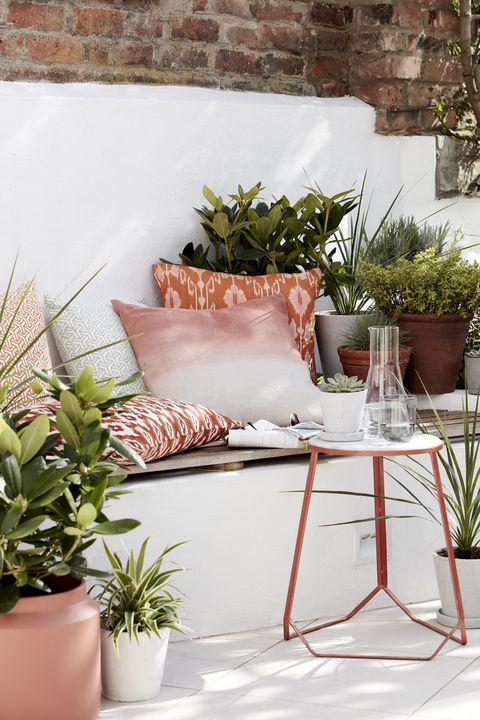
House Beautiful/Mark Scott
Answer these questions and you'll have a clear idea of exactly how you want your garden to work for you. We hope these garden ideas will give you some inspiration...
1. Get your lawn into shape
Look out of your window at your garden and the biggest shape you'll probably see is your lawn. If it's a good, strong shape, it will set the entire garden on the right track. And remember, it doesn't have to be a rectangle – try an oval, circle, square or oblong shape.
You'll need the right tools to complete the job. The experts at price comparison service, PriceRunner, has revealed a rise in searches for nifty robotic lawn mowers (126 per cent) and ride-on mowers (182 per cent) since the pandemic, with the Flymo Easi Glide 300 Electric Mower being the best selling lawn mower this year (April 2021).
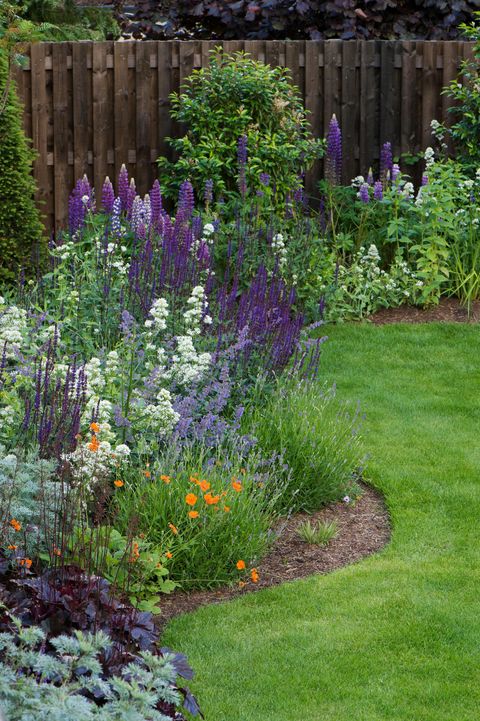
Ian Lamond / Alamy Stock Photo
For ongoing lawn care and maintenance, Stuart Thomas, gardening expert at online garden centre Primrose, advises: 'If your lawn is looking lacklustre, consider the three tenets of sunshine, showers and soil aeration. Cut branches back to keep excessive shade away. Water once a week early in the morning if the UK's frequent rain isn't cutting it. For aeration, take a fork to your lawn and poke heaps of holes. Do all of these and your lawn will be verdant before you know it. And don't mow it too short!'
2. Plan your planting
The best garden designs start with structural plants infilled with pretty, flowering plants. So use evergreen shrubs at the end of each border and as punctuation along the way. Include small shrubs such as box balls, or large evergreens, for example mahonia, for bigger areas.
Once you have this frame, fill the gaps with pretty flowering plants. Try to stick to just five or six different types and arrange them in repeated patterns for a coordinated and harmonious effect. A metre or more in depth is a perfect size for a border, giving you enough space to put smaller plants at the front with taller ones behind.

RHS/Neil Hepworth
Remember, narrow, low-planted beds can define seating or dining areas, as can lines of planted-up troughs – choose evergreen scented plants, such as lavender or Mexican orange blossom. Containers offer the most flexibility though, allowing you to move them around however suits. 'Creeping rosemary is a great plant for edging in containers, as it trails rather than growing upright, is evergreen and covered in blue flowers in spring,' says Tony Woods, managing director of garden design company Garden Club London.
If you don't have room for metre-deep beds, you could place climbers at the back of the border so you can still get height in the planting. In terms of climbing plants, opt for an evergreen like clematis, which provides a beautiful and colourful display.
Tony Woods recommends star jasmine for seating areas: 'It's very well-behaved, produces masses of white, waxy, scented flowers throughout the summer and reacts well to being cut back, so is ideal for positioning behind a seating area where you don't want plants hanging over and can enjoy the scent.'
When you're choosing flowering plants, try to make some of them 'out of season' performers so you have some year-round colour, or put in spring and early summer bulbs to get the garden off to a great start.
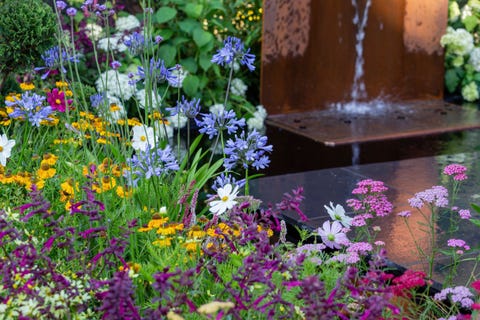
RHS/Neil Hepworth
Concerned about the environmental impact of your garden? If you're looking for ways to make it more sustainable, The Samphire Garden by Sue Townsend demonstrates how you can create a garden that benefits the planet and is still bursting with texture and visual interest.
Set amongst paving of locally reclaimed York Stone, the coastal garden in Suffolk uses a rich palette of drought-tolerant planting, including native seaside plants, grasses and Mediterranean shrubs surrounded by a stone mulch in different sizes. Plants include verbena bonariensis, eryngiums, euphorbias, lavender, achillea, ballota, miscanthus nepalensis, pennisetum, verbena and thymus. Ensure you use permeable surfaces to allow water to be released naturally into the ground.
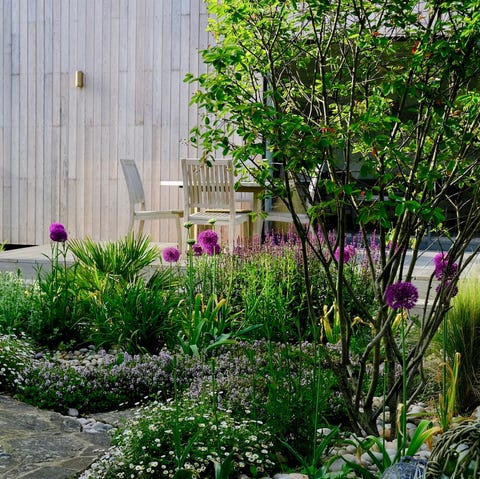
Sue Townsend via Society of Garden Designers
3. Trees
Mature trees can be a starting point for building a scheme. They block the glare of the sun and can also be used as an anchor for shade sails, a hammock, pendant lights or hanging decorations.
Trees can also screen an unattractive view or help to filter noise and air pollution if you live near a busy road. And they benefit nature significantly, providing pollen for insects and shelter for birds, and converting airborne carbon dioxide into oxygen.
In fact, a growing trend is multi-stem trees – planting these can create an architectural showpiece, with the elegant canopies lending themselves to layered underplanting or, if planted exclusively, creating a striking structural statement. As seen below in this modern Suffolk garden by Caitlin McLauglin, multi-stem trees and soft planting creates a deconstructed woodland environment in a front courtyard garden.
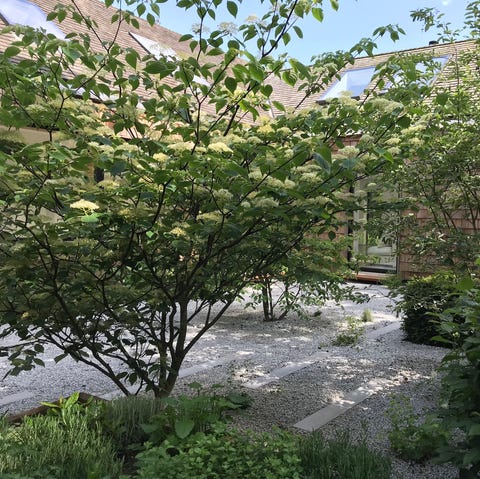
Caitlin McLauglin
'Trees are fantastic as a habitat and food source for wildlife and as a source of carbon capture. They also give structure and architecture to a garden,' says Sarah Squire, Chair of Squire's Garden Centres. 'There are trees for every size and shape of garden, from a small acer in a pot on a balcony or a gorgeous flowering cherry in a back garden, to birch, whitebeam and hornbeam (my personal favourite) for larger spaces.'
4. Beautiful paving
The colour and style of your paving and the way it is laid can provide a strong design direction for the entire garden. For instance, grey or white stone laid in a random pattern will set the scene for a French country look; black or silver paving organised in a regular design will form the perfect backdrop to a sleek and modern scheme; while golden stone arranged in a mixed pattern creates an English country feel.

Need some inspiration? Butter Wakefield created an elaborate paving design of 10 interlinking circles in her Ribbon Wheel garden, each one different in design and size and connected to one another by a 'ribbon' of York cobblestones. The circles, created from a combination of limestone and York stone are laid in a mix of setts and cobbles creating a stunning effect.
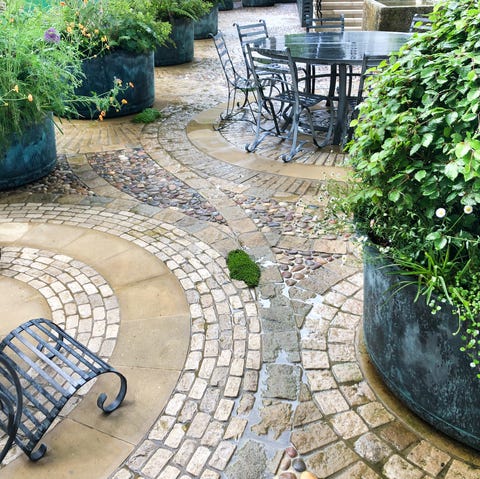
Butter Wakefield via Society of Garden Designers
If you want to create the garden of your dreams, attention to detail is everything. Create a beautiful scheme by coordinating your plants with your choice of paving. For example:
- Grey or white stone looks great with purple and white blooms
- Black and silver paving looks amazing with strong colours such as red, orange and yellow
- Golden paving works with flowers that have soft tones – pink, lavender, and chalky yellow.
Michael John McGarr, director and garden designer at Warnes McGarr & Co, suggests: 'Rather than jet washing the old worn paving, think about something new and exciting like large-format porcelain paving. Porcelain absorbs no water so requires less cleaning than traditional type of paving meaning less pressure washing and much less hard work when multiplied over future years.'
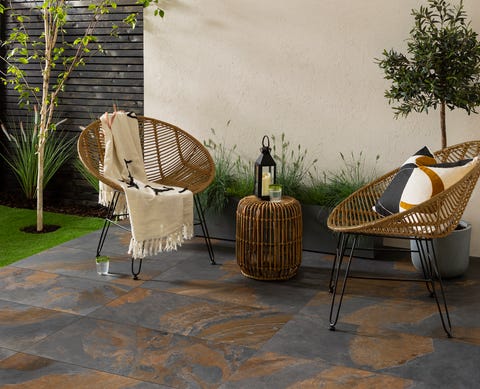
CTD Tiles
Regardless, it's a good idea to create a flow of movement from your property into the garden. 'By ensuring your paving is the same level as your indoor flooring, you can blur the lines between the interior and the exterior of the property,' adds Michael.
5. Distinct levels
Is your garden on different levels? If you don't like the idea of incorporating stone steps, you can achieve a seamless look with your existing lawn, for example, by enabling the flow from one space to the next. As seen in the below photo, garden designer Helen Elks-Smith used grass treads, integrating them into the existing lawn to connect the lower patio to the small sun terrace above.
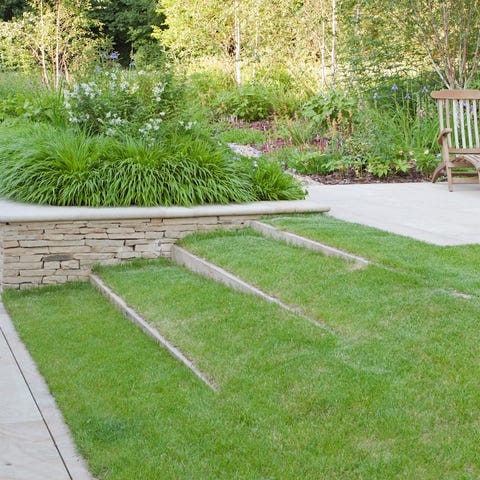
Helen Elks-Smith via Society of Garden Designers
Looking for decking ideas? If you have an uneven or sloping garden, decking is an ideal and cost-effective option for levelling it out. Decking can also have split levels and include steps, making it the ideal space for dining furniture, and due to its use, a decked garden area typically needs to withstand heavy foot traffic.
Environmentally friendly, anti-slip and maintenance-free, Millboard's composite decking boards are an innovative mix of polyurethane and a mineral blend, offering the beauty and versatility of natural wood without the maintenance. This wood-free decking has a non porous outer layer, so it essentially self-cleans so the rain will do the hard work.
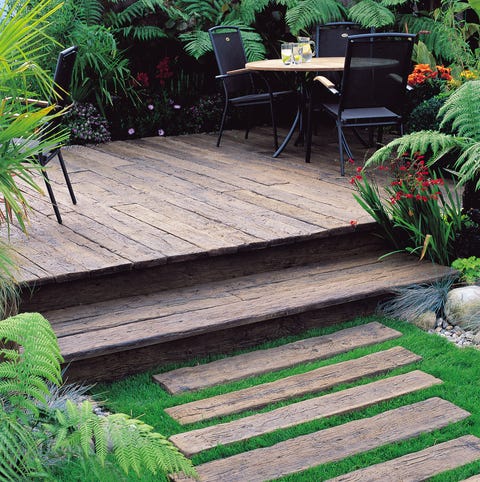
6. The furniture
For smaller courtyards and patios, go for folding furniture, or bench seating that can be tucked under a dining table when not in use. L-shaped sofas can be surprisingly compact, while larger spaces can take full-on seating sets, with matching chairs, sofas and tables, sun loungers and day beds, or on-trend hanging egg chairs or swing seats.
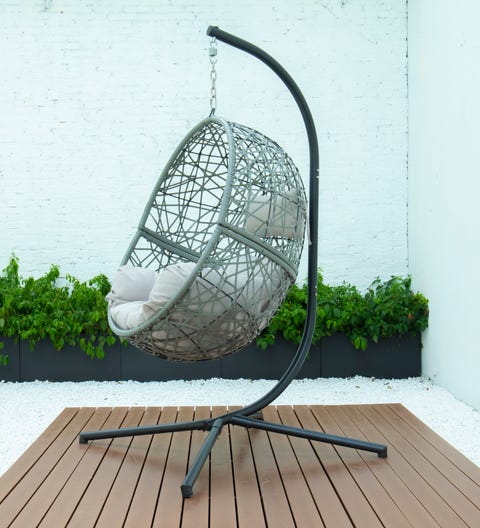
BRIQ
Invest in a good garden furniture set that will last for years to come. Consider the space and allow enough room for each person to be able to sit comfortably and pull out their chair without bumping into anything. And remember, you'll also need room to walk around the table with everyone seated. It takes up much more space than you might think!
According to Claire Belderbos, director of garden landscaping specialists, Belderbos Landscapes, 'a dining table works best in the area of the garden that has early afternoon full or partial sun. Put a smaller seating area where you can enjoy the evening sun'.
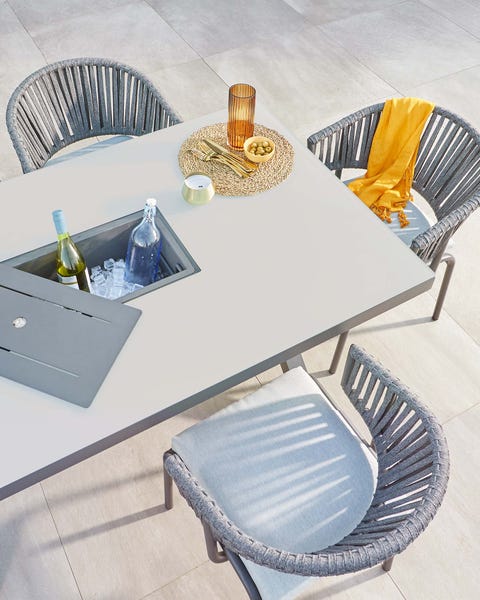
Danetti
If, for example, you can't move your three-piece set indoors over winter, buy furniture covers to protect and extend its life. And whatever garden furniture you buy, don't forget to accessorise with outdoor cushions for extra comfort.
And let's not forget other garden must-haves, including fire pits and chimineas, patio heaters, barbecues and pizza ovens – planning space for these is key, as is where they will be stored or protected once it's winter.
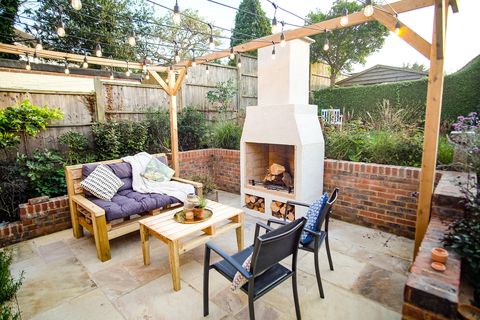
Schiedel
7. Pay attention to your boundaries
In a small garden, boundary walls, fences or hedges may be the biggest element in view, so it's really important for them to look good. They don't have to all be the same but try to provide visual links between them. You could have the same type of fence, for instance, and grow climbers up them in in coordinating colours. If you aren't able to change the fences, whitewash them or clad them with battens or trellis. Check with your neighbours first to establish whose fence it is and ask permission before doing any work.
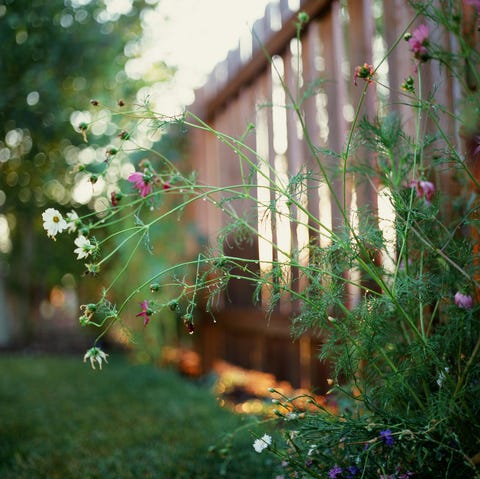
Elizabeth Moehlmann Getty Images
The materials you choose are key, too. For example, timber posts don't have to be confined to fencing a garden off from the neighbours. Carefully positioned within a garden, they can be used to frame plants or seating areas and add extra interest to borders or paths.
A really inventive use can be seen in the NHS 70 Garden for Addenbrooke's Hospital by garden landscape company Bowles & Wyer. They used reclaimed oak posts to frame the view along a meandering path at its centre, positioning them at different heights and angles so that new aspects of the space open up to visitors as they make their way through.

Richard Bloom via Society of Garden Designers
8. Screening and zoning
You should also think about screening areas of your garden to create separate 'rooms'. Introduce hard landscaping in the form of pergolas or fences, or through plants. 'You can't go wrong with hardy rose bushes or tall bamboo,' suggests Jon Holloway, founder of Garden Trading. Alternatively, try a line-up of potted trees.
If space is limited, consider zoning areas of your garden, although this is a good idea for every garden shape and size. 'The garden is definitely an extension of the kitchen and living space,' says Vicky Angell, outdoor living buyer for John Lewis & Partners. 'In part, this is because our homes are, on average, smaller than ever, so we're looking to the outdoors for space to entertain and relax.'
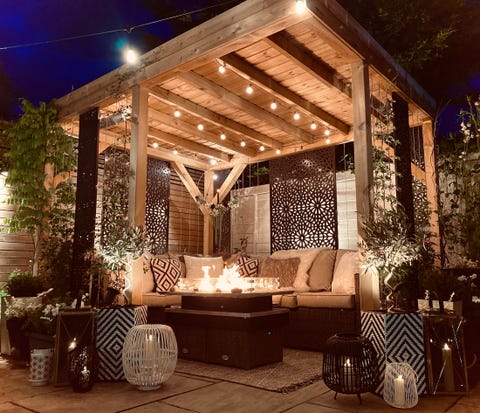
@ourhomeonthefold (via Screen With Envy)
9. Accessorise the fifth room
Think about how you can turn your outdoor space into a relaxing sanctuary with cosy garden decor and tactile furnishings. Essentially you want to create a living room look, it's just outdoors rather than inside, so bear this in mind when on the hunt for decor and accessories.
For example, you could invest in an outdoor rug (Cuckooland sell a great selection of Fab Hab rugs made from recycled plastic) along with chunky knit throws, lanterns, and outdoor cushions for an inviting and snug feel. Reflect light around your chosen spot with a garden mirror; invest in a waterproof speaker; choose citronella candles to keep bugs at bay; keep warm in the evenings with a patio heater, and last but certainly not least, dot smaller potted plants around the space, much as you would with houseplants.
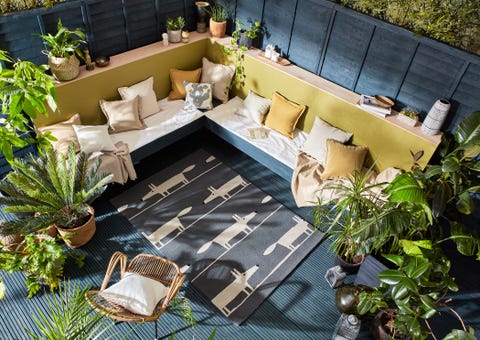
The Rug Seller/Andy Gore
10. Integrate your ornaments
The most important rule with garden ornaments is to nestle them in with the planting. Choose wisely as an ornament or water feature (although it's great for wildlife) that's plonked in the centre of an empty space is unlikely to look good. If it's too small it will look lost and something too big will overwhelm the space; the latter has also been known to devalue your home, so it's something to bear in mind when it's time to sell.
If you like the idea of hearing the trickle of running water in your garden but don't want a fountain, try a simple stone trough and water spout like the one incorporated into Butter Wakefield's Ribbon Wheel garden (below). The antique trough is designed with wall panels hanging above it, incorporating antiqued mirrors to reflect the garden beyond and painted a dark grey to set off the green of the surrounding plants.
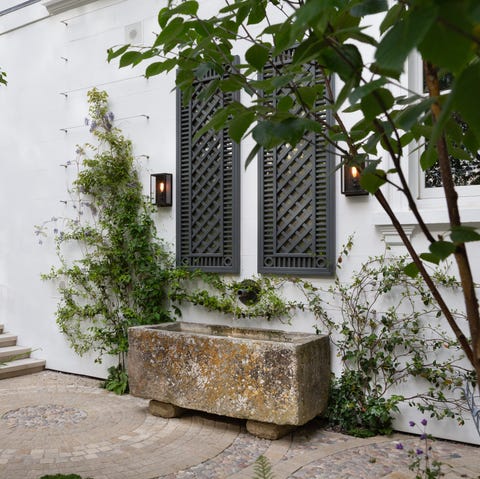
Butter Wakefield via Society of Garden Designers
11. Install a garden room
A garden room is a great way to maximise and extend your space whether you want a home office or a yoga studio, and planning permission is not usually required. Whether it's a large shed or summerhouse, it can be the perfect space for entertaining guests over summer, and can even be used as additional accommodation for guests. Think about ways to make your garden more than just an outdoor area to eat, drink and soak up the sunshine.

Homebase
12. Living walls
Living walls are becoming more popular in garden designs, providing a great way to embrace vertical planting and create maximum drama in your outdoor space. You can position a living wall anywhere, just remember to choose the right plants for that part of the garden, just as you would with a border. There are plenty of green wall kits and living wall planters available too, so shop around to find one that best suits your space.
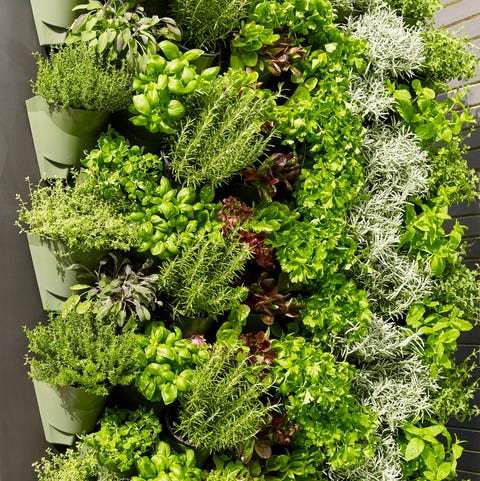
You can also invest in high impact living wall systems, which varies in cost depending on how complex you want it, to fill large expanses of wall.
John Davies incorporated hydroponic walls into the roof and basement gardens of this office building in London. A mix of flowering shrubs and perennials, such as buddleia and fuschia, complements the evergreen planting framework and creates a year-round effect with seasonal colour.
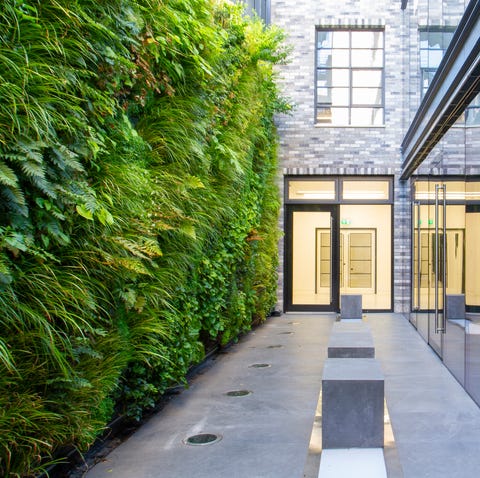
John Davies via Society of Garden Designers
Alternatively, using your garden walls for planting – whether it's with a trellis or containers – is a great way to create an instant living wall. Using climbing plants and wall shrubs such as clematis, roses, honeysuckle or wisteria, will add a vertical element to your outside space.
13. Don't forget the lights
Speaking of lighting, don't underestimate how important it is to create atmosphere in your garden. In exactly the same way that you layer up indoor lighting, do the same for garden lighting and choose a variety of sources (Lights4Fun stock a great range), including fairy lights, festoon lights, wall lights, freestanding lamps and ground lights etc. 'Outdoor lights and a fire pit mean that you can continue to enjoy your space even when the sun sets or if the weather isn't quite what you hoped,' says Jon Holloway.
Whether it's fairy lights or lanterns dotted along a garden path (Lights4Fun stock a great range), the lights you choose will bring character, ambience and atmosphere to your space – and it's essential for dining alfresco well into the evening.

Oliver Perrott Photography Ltd
14. Small space solutions
Vertical planting is key. Make use of fences and walls by planting upwards to maximise space and buy hanging baskets (these are great for front gardens too). In terms of paving, switch to gravel; it's much more affordable. The most important thing to remember is that just because you have a small garden, it doesn't mean you can't enjoy it and make the most of it. There are some great space-saving, foldable or stackable table and chair sets that are perfect for compact spaces – invest in a garden bistro set for style and functionality and deck chairs for easy, instant seating.
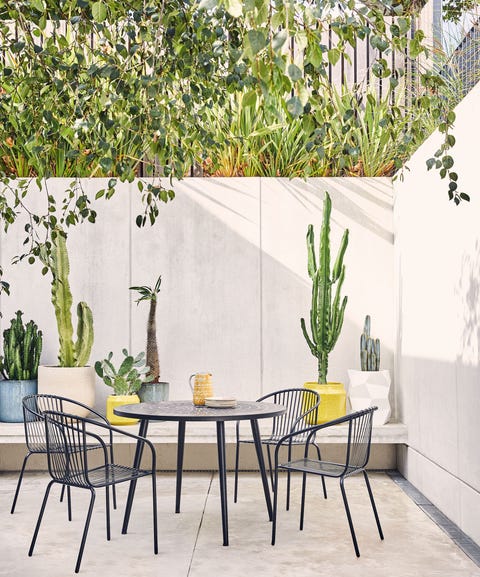
Habitat
15. A family garden
Get smart with landscaping to utilise space in a family garden to make it work for everyone. For example, Adolfo Harrison created a hidden playground in this garden in east London, weaving elements of play throughout the design so that both children and adults can enjoy the space.
Monkey bars form a pergola to which swings and slides can be attached, boulder stepping stones are laid out to enable children to jump from one to the other along the length of the garden, and two moon benches provide a snug place where they can sit, set within a living wall to create a playful face. Mirrors are used to make the space feel bigger and a 'ceiling' created by the canopy of long-stemmed bamboos focus attention within the space and create a more intimate atmosphere.
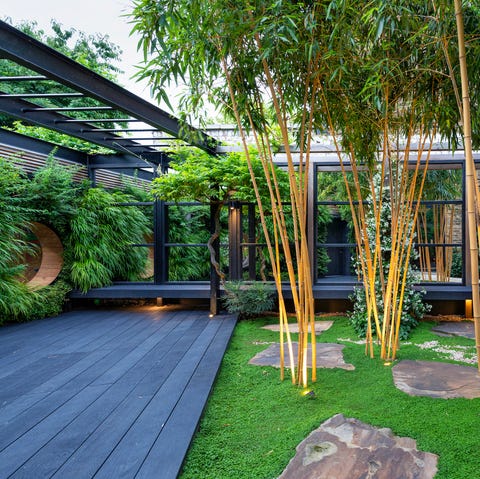
Richard Bloom via Society of Garden Designers
Kids love going out in the garden for some playtime but zoning an area is key, as small family gardens can often be dominated by play equipment, leaving little room for anything else. While you would need to have a large garden to install a slide or playhouse, for more restricted spaces, sand tables or mud kitchen play sets in a corner will work great, and it will entertain kids for hours.
16. Don't forget wildlife
Always consider the impact your garden design has on wildlife. For example, do your best to help bees by planting bee-friendly plants, speak to your neighbours about creating a hedgehog highway, and buy some bird feeders to hang on fences or from tree branches. Bee hotels, wildlife ponds, log piles, plants for pollinators and compost heaps will continue to increase in popularity.
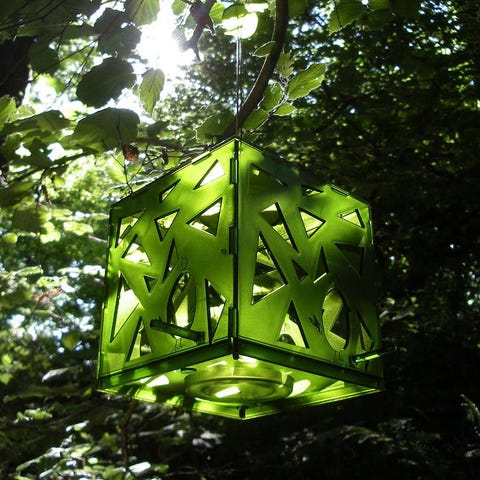
Notonthehighstreet.com
Bird Feeder
Flock Follies notonthehighstreet.com
Ready to create your dream garden? Read these guides for more advice: • 6 questions to ask your garden designer • 9 things you need to know about garden landscaping
Follow House Beautiful on Instagram.
Like this article? Sign up to our newsletter to get more articles like this delivered straight to your inbox.
SIGN UP
Love what you're reading? Enjoy House Beautiful magazine delivered straight to your door every month with Free UK delivery. Buy direct from the publisher for the lowest price and never miss an issue!
SUBSCRIBE
16 great books for gardening and indoor plant inspiration
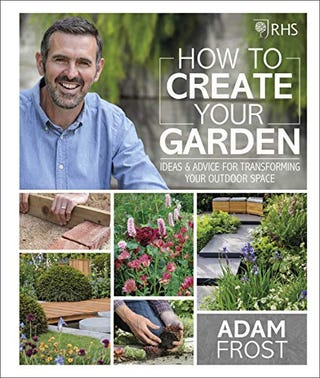
Garden book
RHS How to Create your Garden: Ideas and Advice for Transforming your Outdoor Space
Adam Frost's practical, no-nonsense approach will help you plan and build a garden that works for you. The Gardeners' World presenter takes you step by step through the whole process, from simple garden design ideas to a full garden makeover.
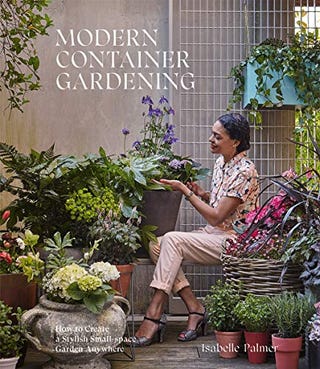
Garden book
Modern Container Gardening: How to Create a Stylish Small-Space Garden Anywhere
Isabelle Palmer shows you how to make the most of every little space with a series of projects for small gardens, singular containers and window boxes, that can be completed in a day or weekend. Perfect for novice gardeners,Modern Container Gardening offers beautiful photography and clear step-by-step instructions.
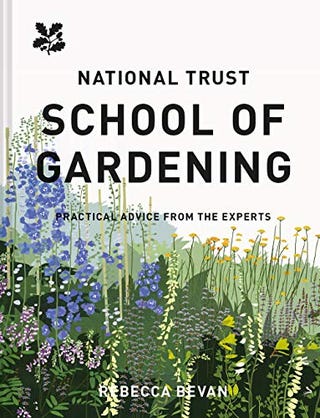
Garden book
National Trust School of Gardening: Practical Advice from the Experts
National Trust amazon.co.uk
£14.99
The National Trust employs over 500 gardeners with an extraordinary wealth of expertise. And now, in this in-depth guide, they pass on their wisdom and provide the answers any new and seasoned gardener is looking for. This book is intended to give you inspiration and confidence to make the most of your garden, without being overwhelmed with unnecessary technical detail.

Garden book
Veg in One Bed: How to Grow an Abundance of Food in One Raised Bed, Month by Month
Veg In One Bed explains how to build your bed and grow from seed, as well advice on planting, feeding, and harvesting. YouTube gardening star Huw Richards shows how to guarantee early success by starting off young plants on a windowsill and suggests what to grow in each part of the bed.

Garden book
The Complete Gardener: A Practical, Imaginative Guide to Every Aspect of Gardening
Monty Don offers straightforward gardening advice in this book, revealing the secrets of growing vegetables, fruits, flowers, and herbs, while respecting the needs of the environment by gardening organically. You can also enjoy a tour of his Herefordshire garden, including his flower garden, herb garden, kitchen garden, and more.
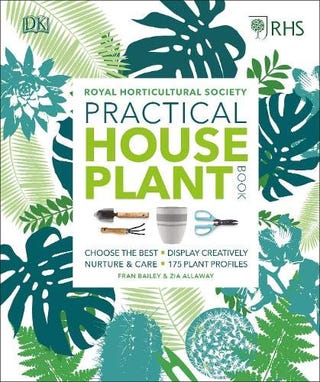
Plants book
RHS Practical House Plant Book
The Practical House Plant Book by the RHS contains a dozen step-by-step projects to help you assemble an eye-catching terrarium, create a floating kokedama 'string garden', or propagate succulents. Complete with 175 in-depth plant profiles, this is an essential practical guide for indoor gardeners.
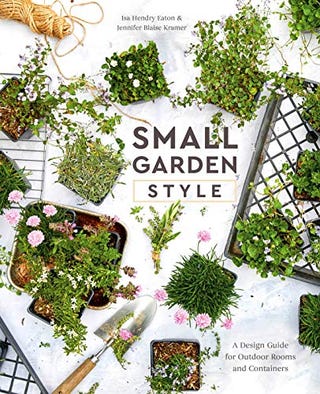
Garden book
Small Garden Style: A Design Guide for Outdoor Rooms and Containers
Ten Speed Press amazon.co.uk
£12.35
A small garden space – an urban patio, a tiny backyard, or even just a pot by your door – doesn't have to sacrifice style. InSmall Garden Style, garden designer Isa Hendry Eaton and lifestyle writer Jennifer Blaise Kramer show you how to use good design to create a joyful, elegant, and exciting yet compact outdoor living space.
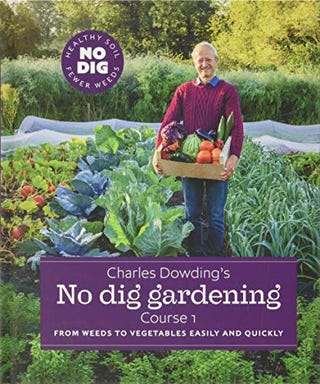
Garden book
Charles Dowding's No Dig Gardening: From Weeds to Vegetables Easily and Quickly: Course 1
No Dig Garden amazon.co.uk
£18.65
Charles Dowding, innovator of no dig, teaches you everything you need to know about this method of organic gardening. With 19 chapters, you'll learn how to use no dig on different soil types, recognise and massively reduce the different types of weeds, know the difference between soil and types of compost, and grow an abundance of vegetables using the no dig method.
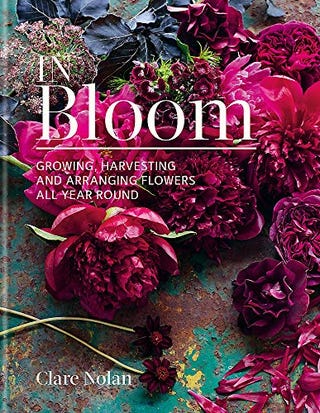
Plants book
In Bloom: Growing, harvesting and arranging flowers all year round
Kyle Books amazon.co.uk
£19.55
Get all the inspiration you need for planting cut flowers, and fill your home with colour and the gorgeous scent of the garden year-round withIn Bloom. Clare Nolan reveals her secrets for growing a bountiful harvest as well as styling spectacular homegrown displays in this beautifully designed book.
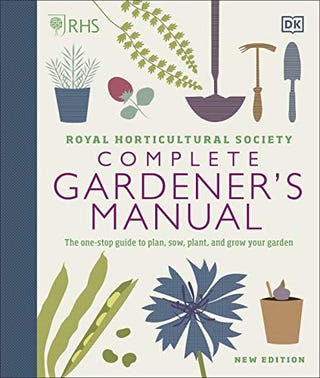
Garden book
RHS Complete Gardener's Manual
The RHS'Complete Gardener's Manual will help you choose plants that will thrive in your space, design a border for year-round colour, grasp different pruning techniques, discover how to protect your veg patch from pests, and make the best compost.

Garden book
Wildlife Gardening: For Everyone and Everything
Bloomsbury Wildlife amazon.co.uk
£10.19
Do you want to attract more bees, birds, frogs and hedgehogs into your garden? InWildlife Gardening for Everyone and Everything,Kate Bradbury teams up with the Wildlife Trusts and the RHS to help you discover how you can make your garden, balcony, doorstep or patio a haven for garden wildlife. You'll find handy charts, practical projects and fact files.

Plants book
My House Plant Changed My Life: Green wellbeing for the great indoors
Gardener and TV presenter David Domoney is a firm believer that indoor plants can make 'a practical and emotional contribution to our wellbeing'. In this book, David explains the hard science behind the positive effect of the humble houseplant on wellness, and provides expert tips on how to keep your plants thriving, plus shares his top 50 life-enhancing houseplants.

Garden book
RHS Encyclopedia of Garden Design: Planning, Building and Planting Your Perfect Outdoor Space
If you're looking for new garden ideas, theRHS Encyclopedia of Garden Design will guide you from planning to planting, such as choosing the correct materials for your structures and assessing your drainage, to laying patios, making ponds, and planting perennials.

Garden book
How to Create an Eco Garden: The practical guide to sustainable and greener gardening
Lorenz Books amazon.co.uk
£11.29
This planet-friendly book is filled with ideas for creating your own eco garden on any scale, from a small courtyard to a large garden or allotment. Discover organic techniques that improve biodiversity, learn the value of using recycled and reclaimed materials for landscaping, and take on simple projects such as making a pond and a wildlife hotel.

Plants book
RHS Encyclopedia Of Plants and Flowers
Drawing on expert advice from the RHS, this best-selling reference book – organised by colour, size, and type, rather than as an A-Z directory – will help you select the right varieties for your outdoor space.

Garden book
Build a Better Vegetable Garden: 30 DIY Projects to Improve your Harvest
Frances Lincoln Publishers Ltd amazon.co.uk
£12.55
Joyce and Ben Russell have devised 30 kitchen garden projects, devised to either extend the season, protect crops from pests or improve yields. These projects transform your vegetable plot into somewhere more productive, more attractive and more secure.
This content is created and maintained by a third party, and imported onto this page to help users provide their email addresses. You may be able to find more information about this and similar content at piano.io
Show Me Ideas For Landscape Gardens
Source: https://www.housebeautiful.com/uk/garden/designs/a495/garden-design-ideas/
Posted by: sabalahavock.blogspot.com

0 Response to "Show Me Ideas For Landscape Gardens"
Post a Comment